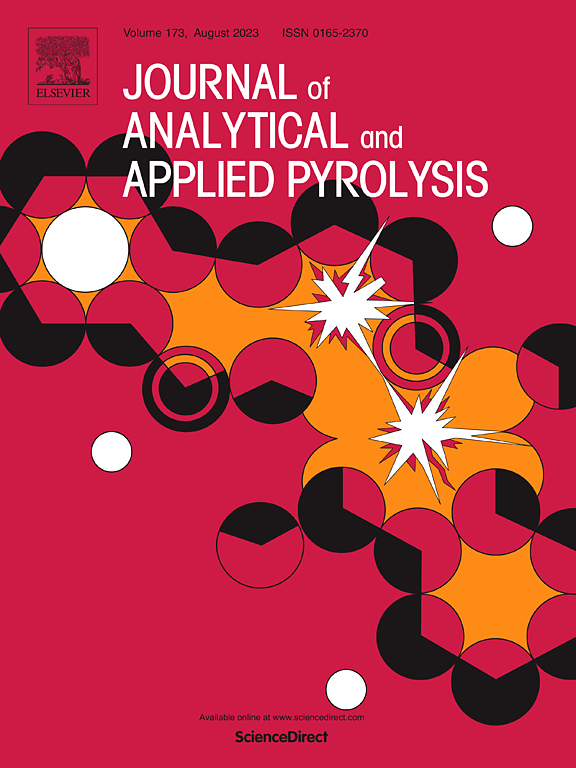Study on the preparation of NiFe2O4@CeO2-ZSM-5 and its application in the coupled catalytic reforming of bamboo sawdust via steam gasification
IF 5.8
2区 化学
Q1 CHEMISTRY, ANALYTICAL
引用次数: 0
Abstract
Utilizing biomass steam gasification is an effective way to produce green hydrogen and achieve clean energy. This study focuses on biomass gasification coupled with inline co-steam catalytic reforming (BGCSR) to enhance hydrogen yield and tar removal rates. In the BGCSR process, a composite support loaded with NiFe2O4 catalyst is used for the gasification of bamboo sawdust coupled with catalytic reforming to generate hydrogen-rich syngas. First, CeO2 and ZSM-5 are prepared as a composite support, and then NiFe2O4 is loaded for application in the BGCSR process. The NiFe2O4@CeO2-ZSM-5 catalyst demonstrates a positive effect on hydrogen yield, achieving a maximum H2 yield of 336.15 mmol/g under optimal conditions, which is an increase of 121.92 mmol/g compared to the absence of a catalyst and an improvement of 25.89 mmol/g compared to using ZSM-5 alone as a support. After being reused seven times, the catalyst maintains a high stability in H2 yield, indicating that the CeO2 and ZSM-5 composite support significantly enhances the activity and stability of the NiFe2O4 catalyst. These results are related to the properties of the composite catalyst support, where CeO2 inhibits the decomposition of ZSM-5 and increases the lattice oxygen content. The redox cycling of Ce3 + and Ce4+ improves the surface properties of the catalyst, and the generated oxygen vacancies effectively promote the reforming reactions of tar and steam. Overall, this research provides a novel and effective method for the preparation of catalysts for biomass gasification combined with inline co-steam catalytic reforming to minimize tar production.
NiFe2O4@CeO2-ZSM-5的制备及其在竹木屑蒸汽气化耦合催化重整中的应用研究
利用生物质蒸汽气化是生产绿色氢、实现清洁能源的有效途径。本研究的重点是生物质气化结合在线共蒸汽催化重整(BGCSR),以提高氢气收率和焦油去除率。在BGCSR工艺中,采用负载NiFe2O4催化剂的复合载体对竹木屑进行气化与催化重整,生成富氢合成气。首先制备CeO2和ZSM-5作为复合载体,然后加载NiFe2O4用于BGCSR工艺。NiFe2O4@CeO2-ZSM-5催化剂对H2产率有积极的影响,在最佳条件下H2产率达到336.15 mmol/g,比不加催化剂提高了121.92 mmol/g,比单独使用ZSM-5催化剂提高了25.89 mmol/g。重复使用7次后,催化剂的H2产率仍保持较高的稳定性,说明CeO2和ZSM-5复合载体显著提高了NiFe2O4催化剂的活性和稳定性。这些结果与复合催化剂载体的性质有关,其中CeO2抑制了ZSM-5的分解并增加了晶格氧含量。Ce3 +和Ce4+的氧化还原循环改善了催化剂的表面性能,生成的氧空位有效地促进了焦油和蒸汽的重整反应。总的来说,本研究为制备生物质气化催化剂提供了一种新颖有效的方法,结合在线共蒸汽催化重整,以减少焦油的产生。
本文章由计算机程序翻译,如有差异,请以英文原文为准。
求助全文
约1分钟内获得全文
求助全文
来源期刊
CiteScore
9.10
自引率
11.70%
发文量
340
审稿时长
44 days
期刊介绍:
The Journal of Analytical and Applied Pyrolysis (JAAP) is devoted to the publication of papers dealing with innovative applications of pyrolysis processes, the characterization of products related to pyrolysis reactions, and investigations of reaction mechanism. To be considered by JAAP, a manuscript should present significant progress in these topics. The novelty must be satisfactorily argued in the cover letter. A manuscript with a cover letter to the editor not addressing the novelty is likely to be rejected without review.

 求助内容:
求助内容: 应助结果提醒方式:
应助结果提醒方式:


